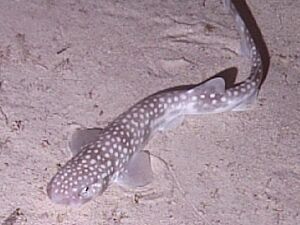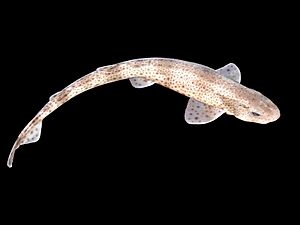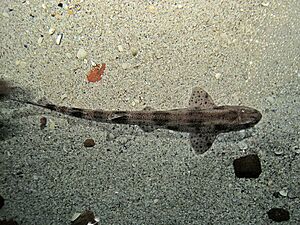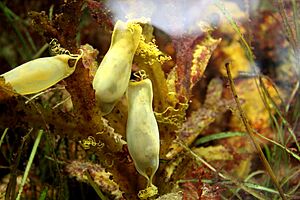Scyliorhinidae facts for kids
Quick facts for kids Scyliorhinidae |
|
|---|---|
 |
|
| A Whitesaddled catshark, Scyliorhinus hesperius | |
| Scientific classification |
|
| Kingdom: | Animalia |
| Phylum: | Chordata |
| Class: | Chondrichthyes |
| Order: | Carcharhiniformes |
| Family: | Scyliorhinidae T. N. Gill, 1862 |
Catsharks (scientific name: Scyliorhinidae) are a fascinating group of sharks. They are part of a larger group called Carcharhiniformes, also known as ground sharks. While most are called catsharks, some species were once known as dogfish. You can often tell them apart because catsharks lay eggs, while dogfish usually give birth to live young.
Catsharks are mostly bottom feeders. This means they eat small creatures like invertebrates (animals without backbones) and tiny fish found on the seabed. Good news for us: catsharks are not considered harmful to humans.
Contents
Discovering Catsharks
There are many different kinds of catsharks! Here are a few of the main groups, called genera:
- Cephaloscyllium T. N. Gill, 1862
- Poroderma A. Smith, 1838
- Scyliorhinus Blainville, 1816
What Makes Them Special?
Catsharks have unique features. They have long, cat-like eyes. They also have two small fins on their back, called dorsal fins, placed far back on their bodies. Most catsharks are quite small. They usually grow to about 80 centimeters (31 inches) long. However, some, like the nursehound (Scyliorhinus stellaris), can reach up to 1.6 meters (5.2 feet).
Many catshark species have beautiful patterns. These patterns can be stripes, patches, or spots. Some catsharks, like those in the Apristurus group, are mostly dark. They have long fins near their tail. Their snouts (noses) are often flat.
Amazing Swell Sharks
Some catsharks, like the "swell sharks" from the Cephaloscyllium group, have a cool trick. When they feel threatened, they can gulp down water or air. This makes their stomachs swell up! They can become one to three times bigger, making them look much more intimidating to predators.
Glowing in the Dark
Did you know some catsharks can glow? Species like the chain catshark are biofluorescent. This means they can absorb light and then emit it as a different color, making them appear to glow in the ocean's dim light.
Where Do Catsharks Live?

Catsharks live all over the world. You can find them on seabeds in both warm (tropical) and cooler (temperate) oceans. They live in many different depths. Some prefer very shallow waters near the shore. Others, like the Apristurus species, live in deep waters, sometimes more than 2,000 meters (6,600 feet) down!
The red-spotted catshark, for example, lives in rocky waters off the coast of Peru to Chile. It moves to deeper waters when winter arrives. Many catsharks tend to stay in small areas. Young and adult chain dogfish live on the soft or rocky bottom of the Atlantic Ocean. They are found from Massachusetts all the way to Nicaragua. Adults often choose soft, sandy bottoms. This might be because these spots are good for laying their eggs.
How Catsharks Live Their Lives
Catsharks are not known for long journeys. They are not very strong swimmers. Many species are nocturnal, meaning they are active at night. During the day, they might sleep close together in rocky hiding spots. When night falls, they head out to hunt for food.
Some catsharks, like the small spotted catshark (Scyliorhinus canicula), show something called habitat segregation. This means males and females live in different areas. Males often prefer open seabeds. Females, on the other hand, tend to live in caves or more sheltered spots. Some catsharks lay their eggs in special places. These places can act as safe nurseries for the baby sharks when they hatch.
Catshark Life Cycle
Many catshark species lay eggs. These eggs are protected inside tough cases. These cases have curly tendrils at each end. People often call them "mermaid's purses." The tendrils help the egg cases attach to the seabed.
Mermaid's Purses
It takes a long time for a baby catshark to hatch from its egg, sometimes almost a year! Some catshark mothers hold onto their eggs inside their bodies for a while. They release them only a few months before the baby shark is ready to hatch. Other catsharks give birth to live young. This happens after the embryos have fully developed inside the mother. When it's time to reproduce, catsharks have special ways of mating to ensure their species continues.



